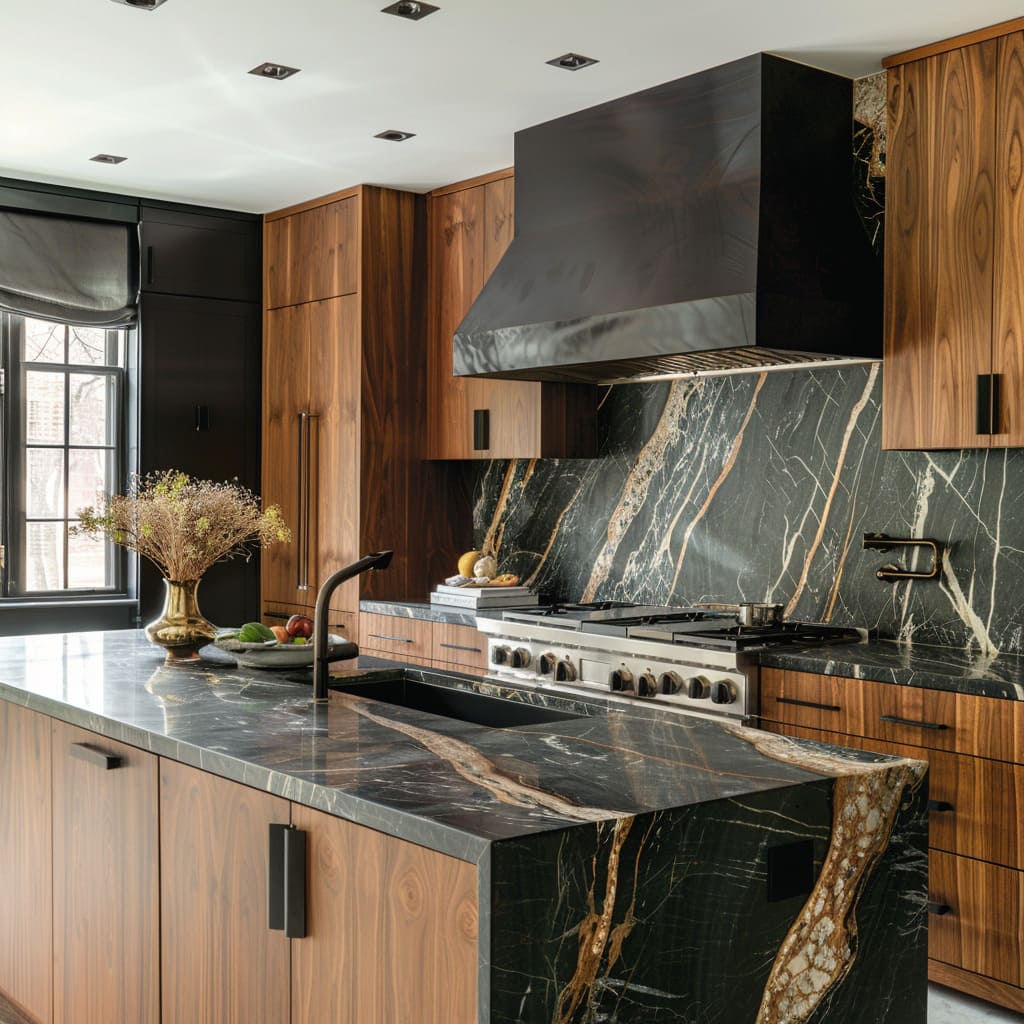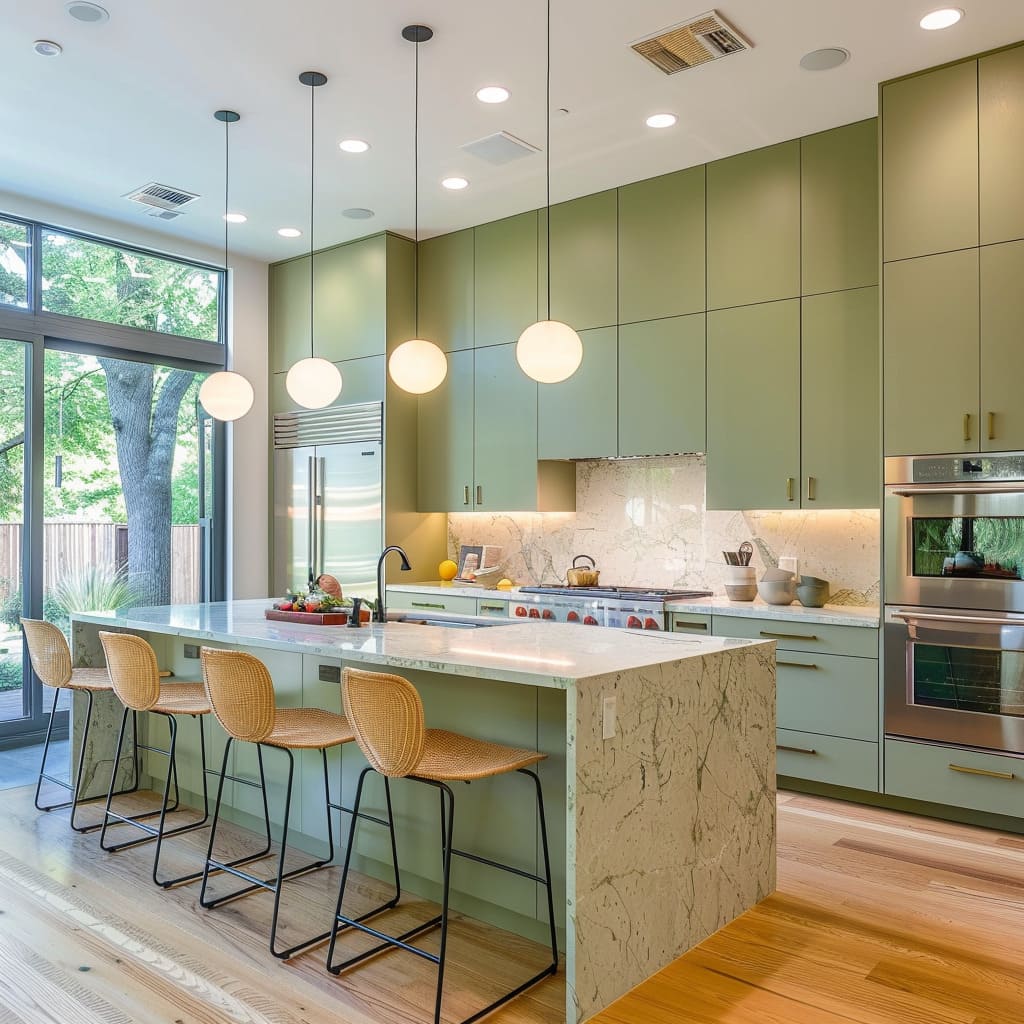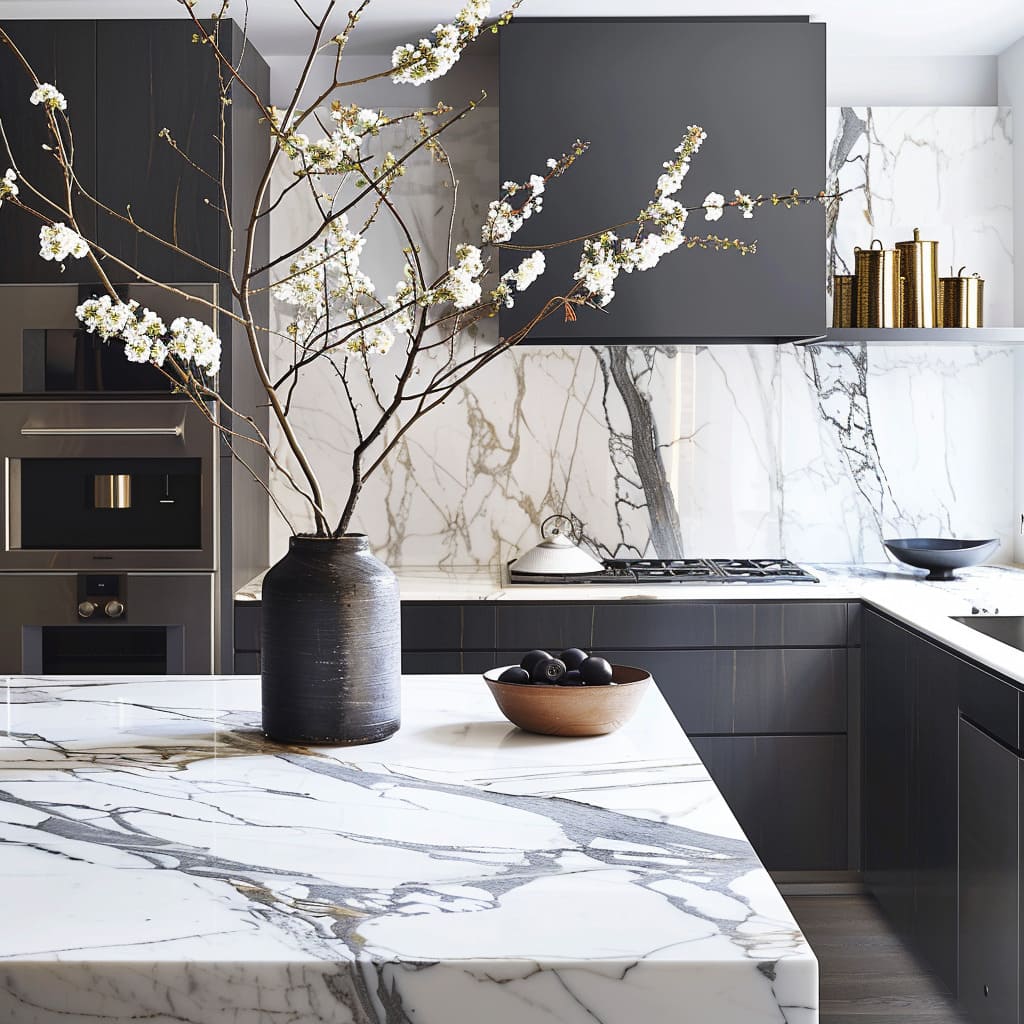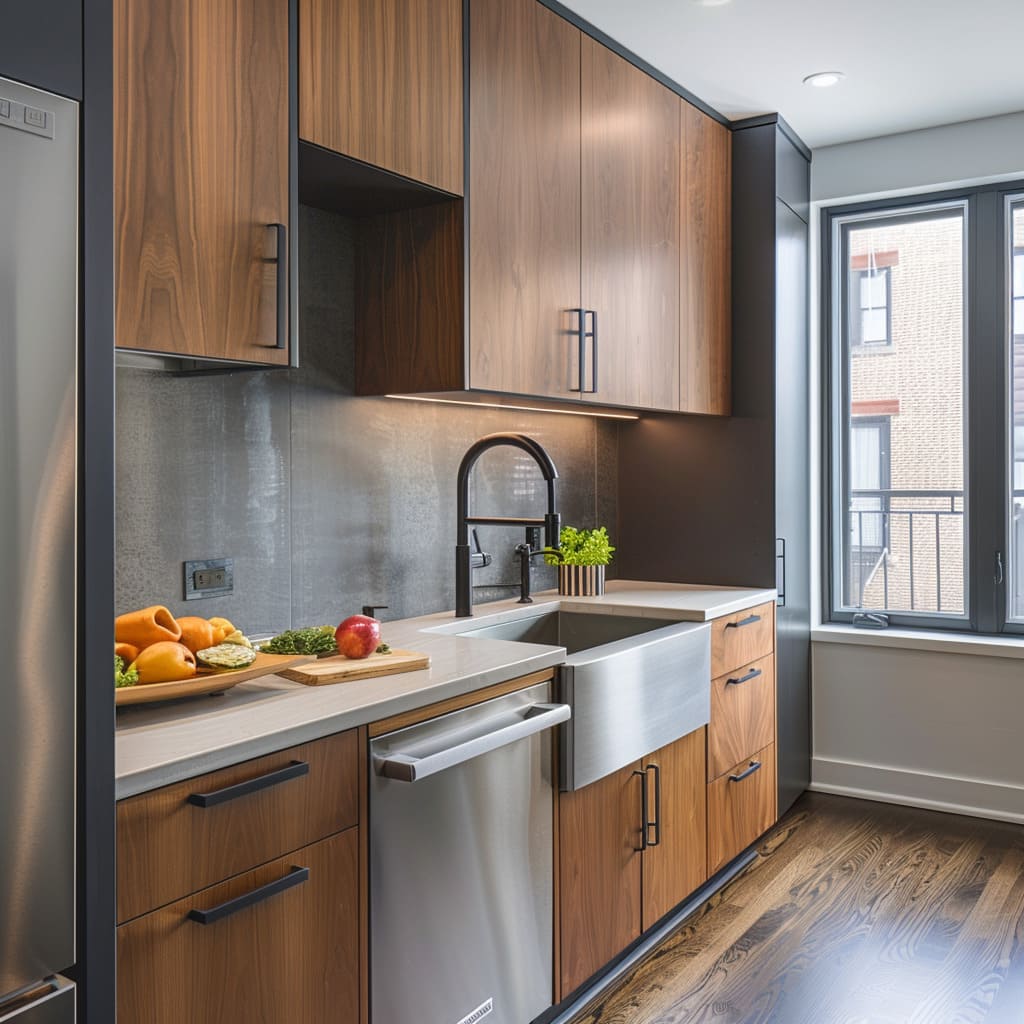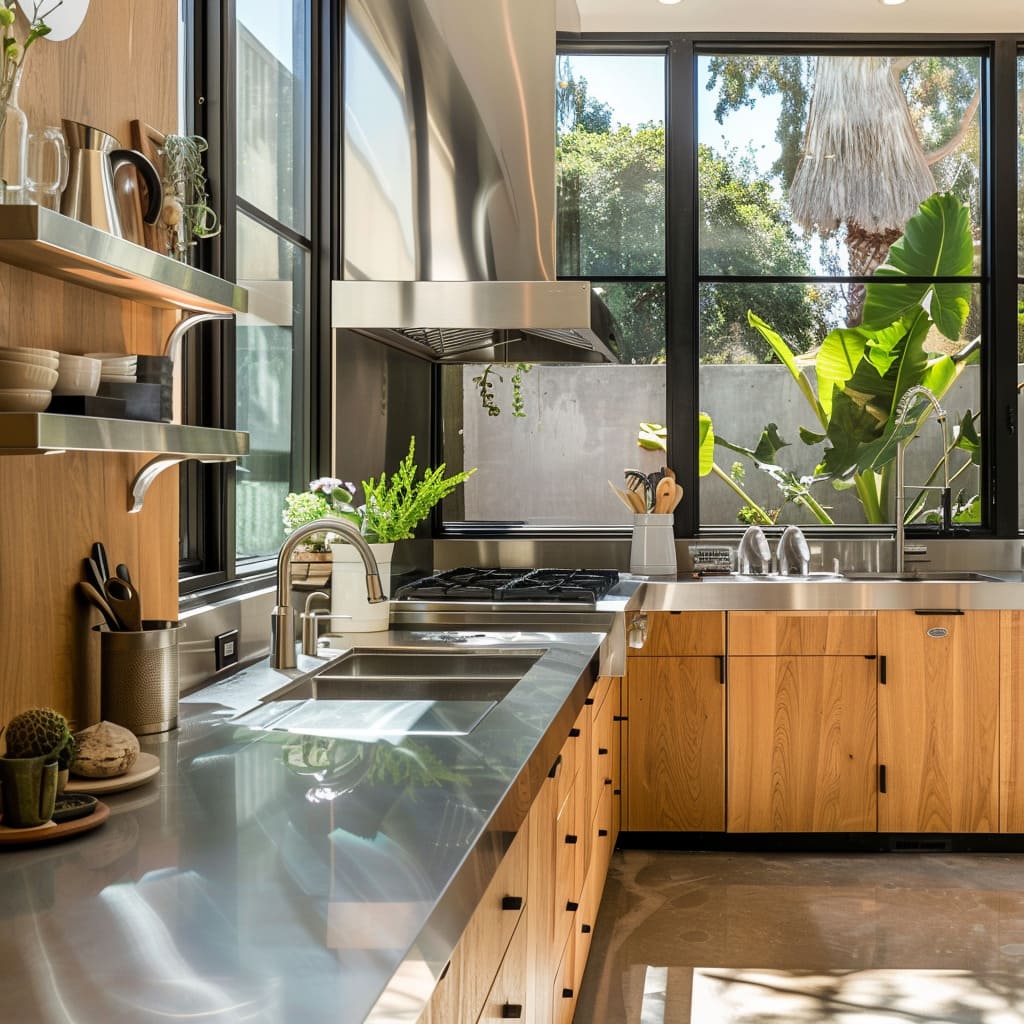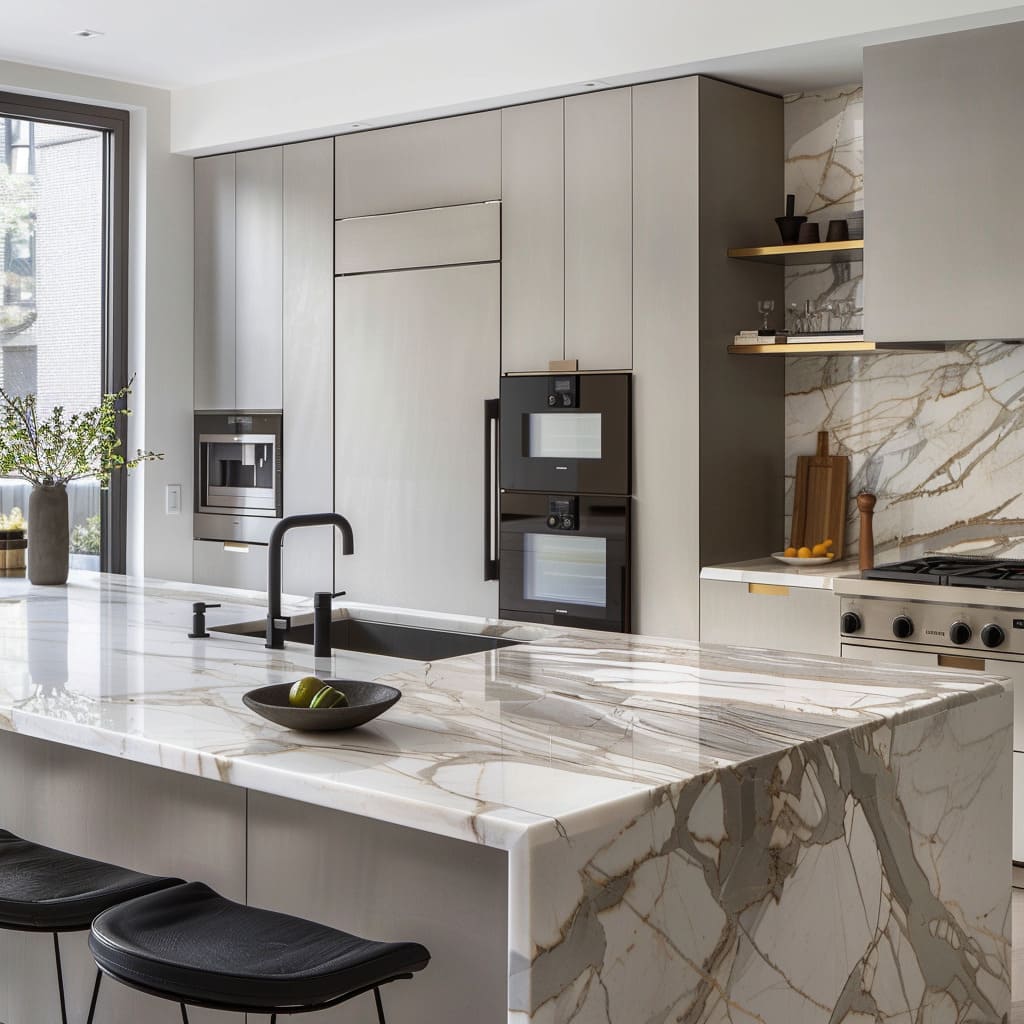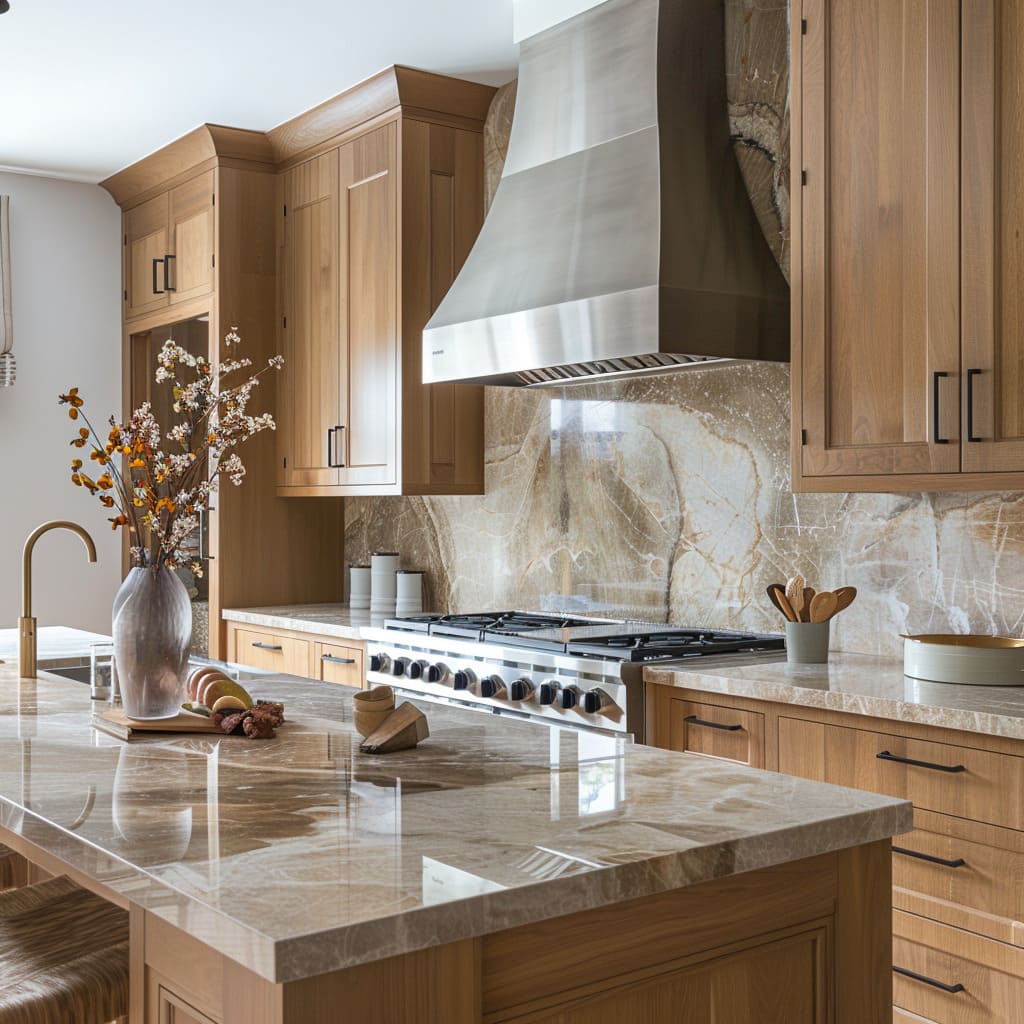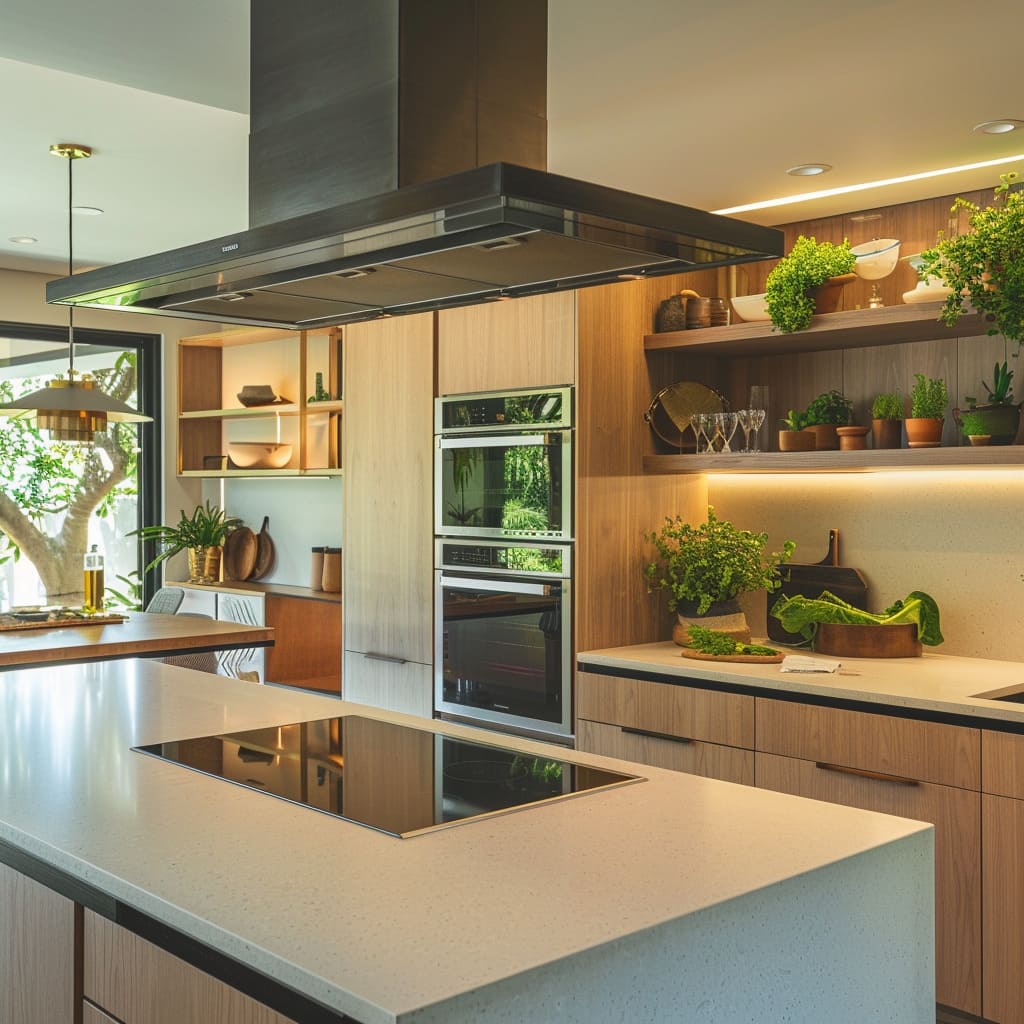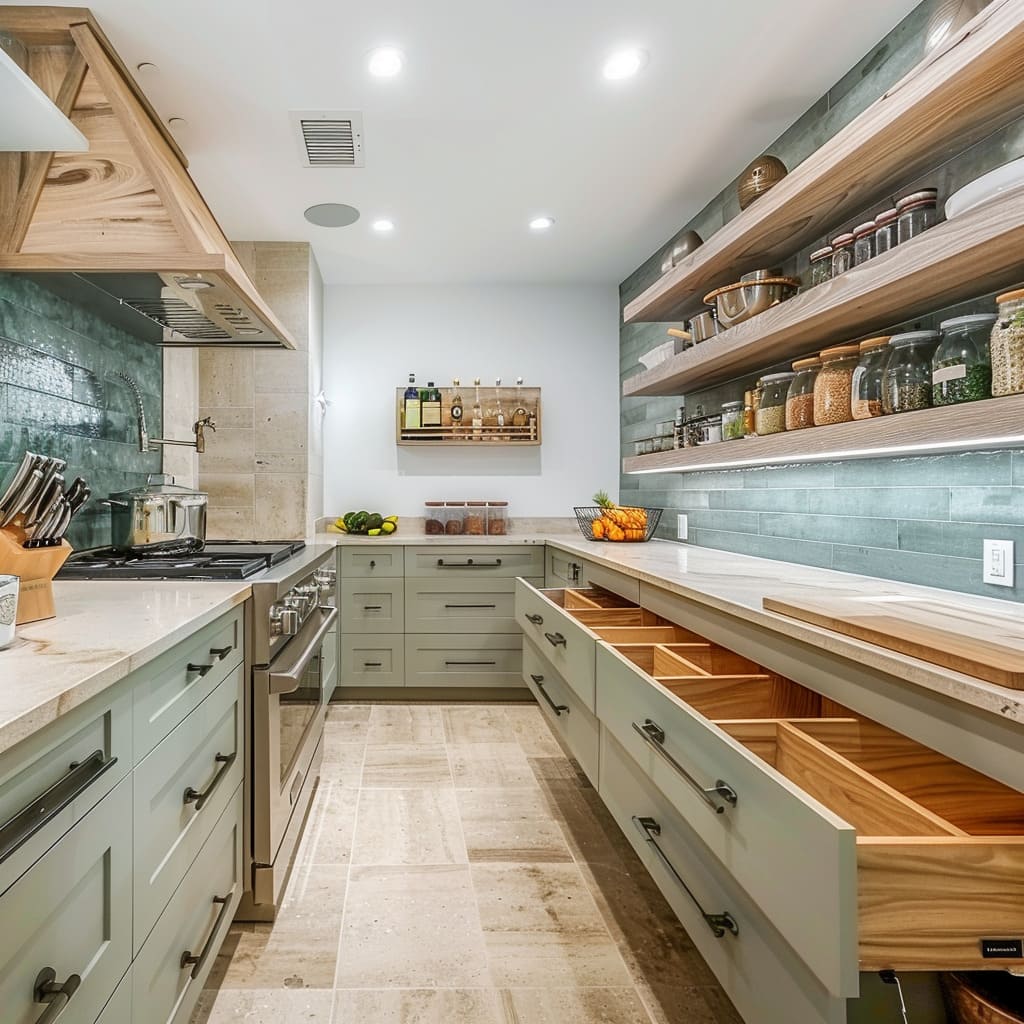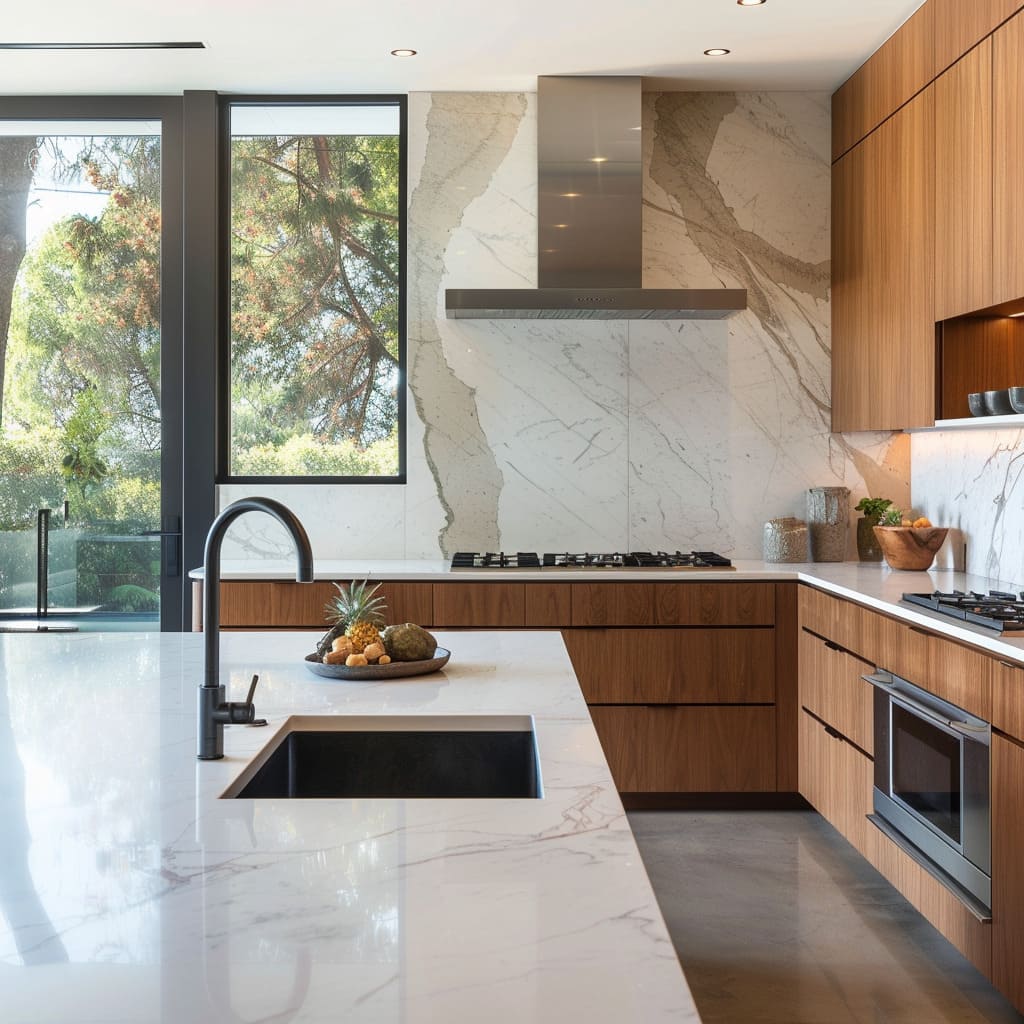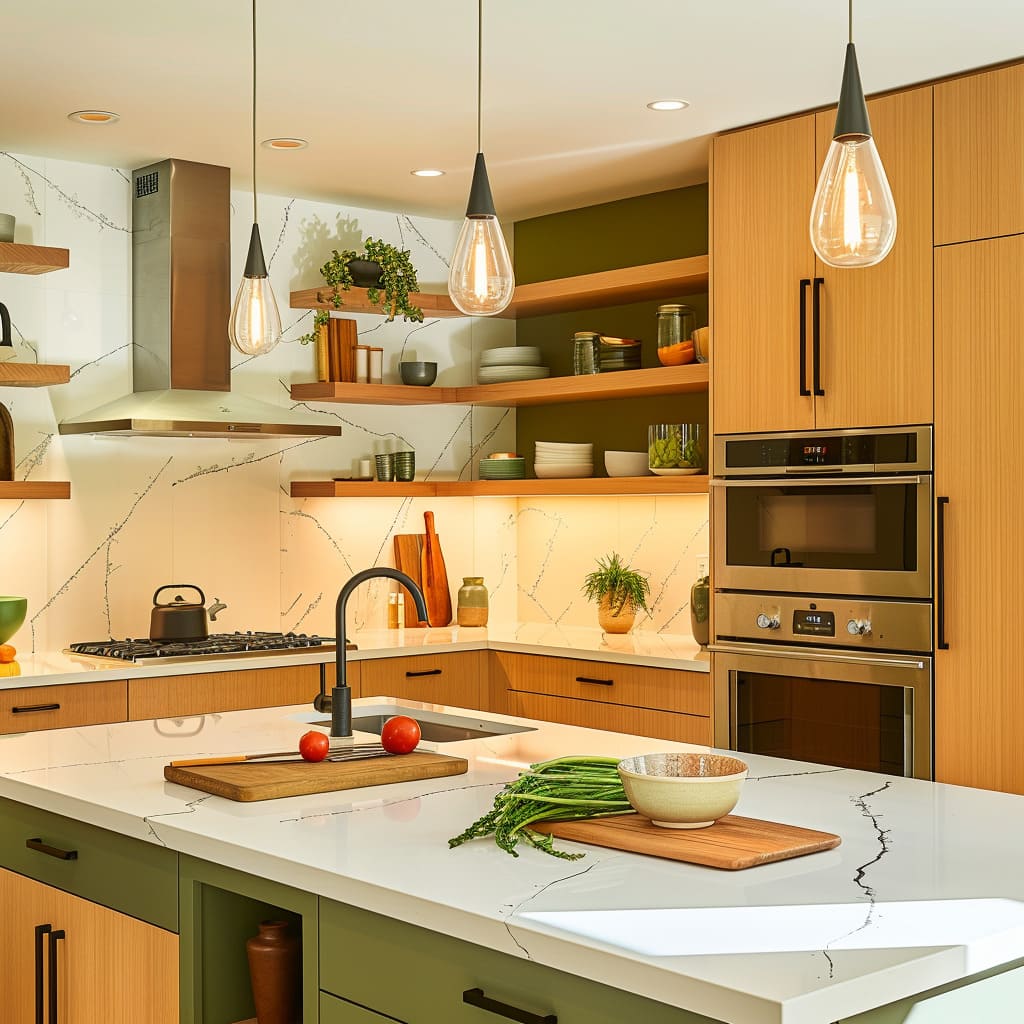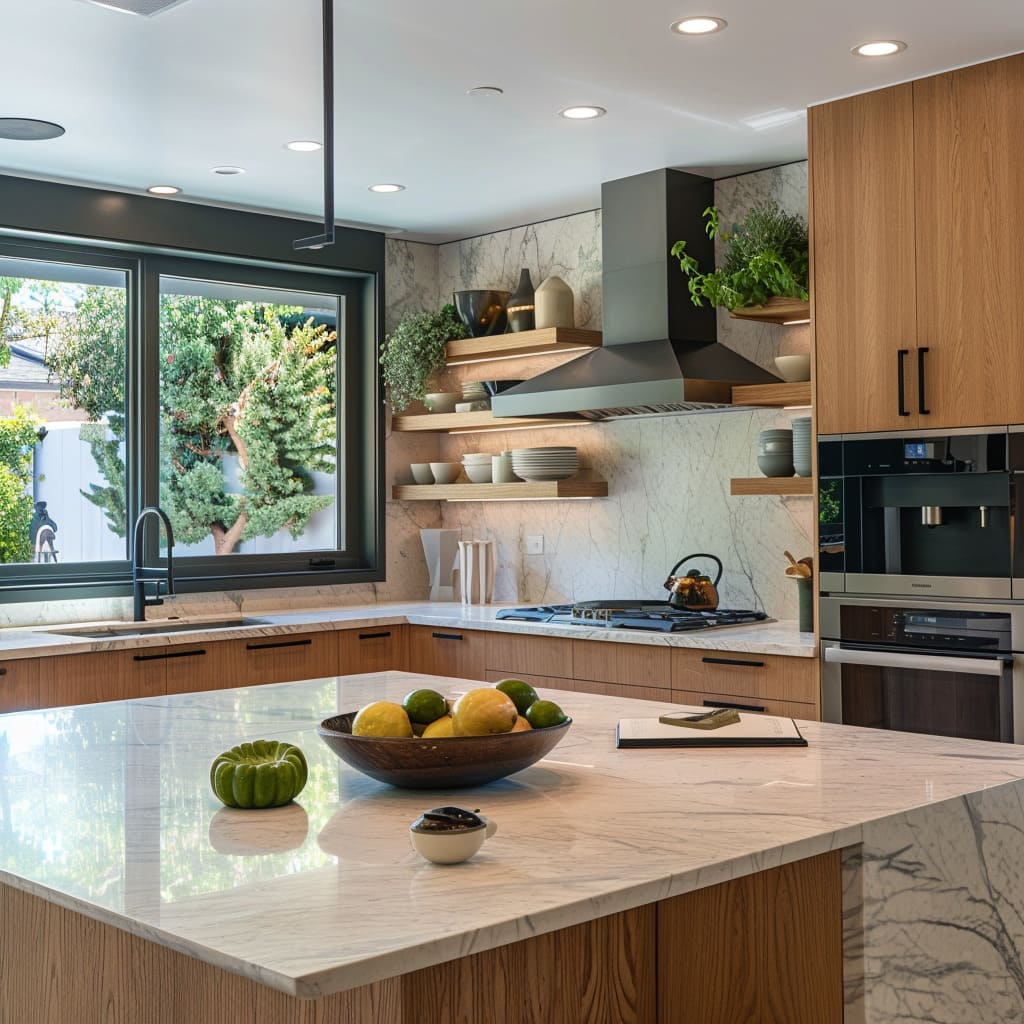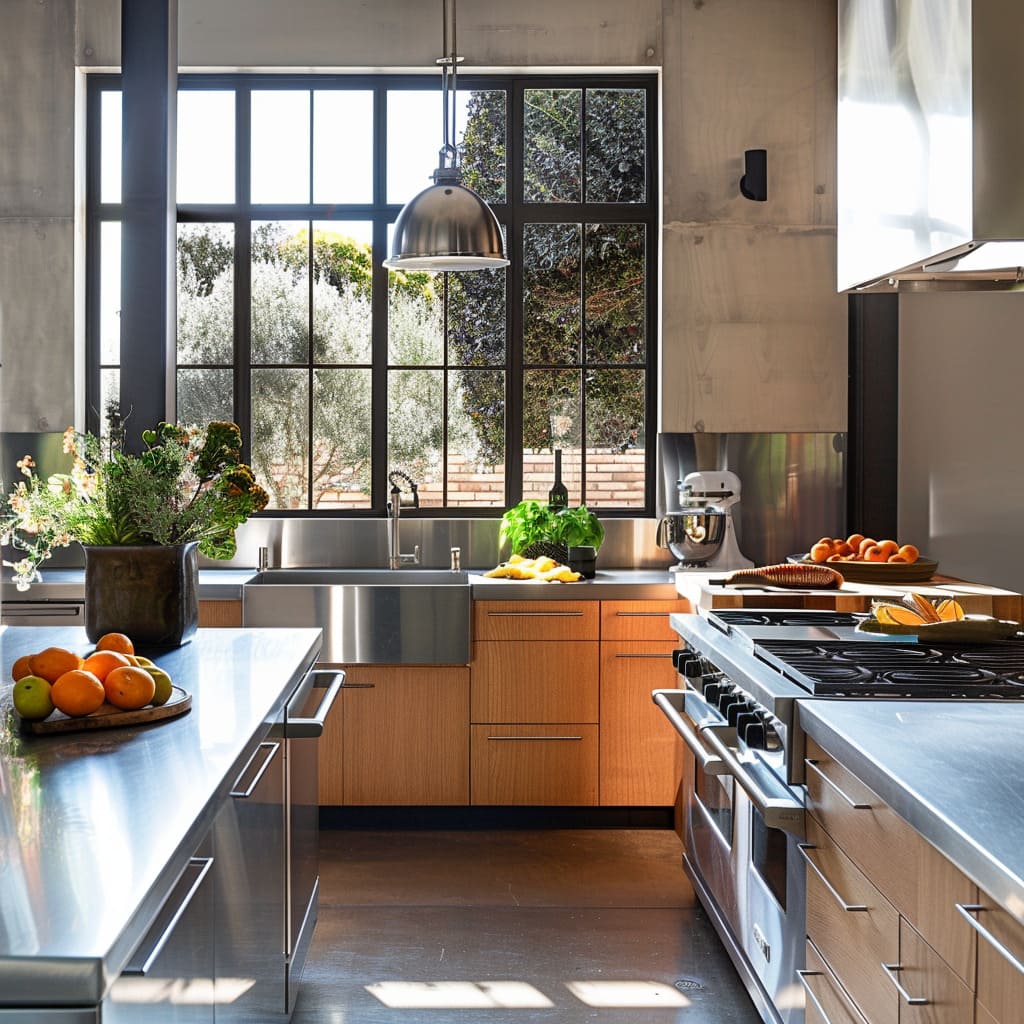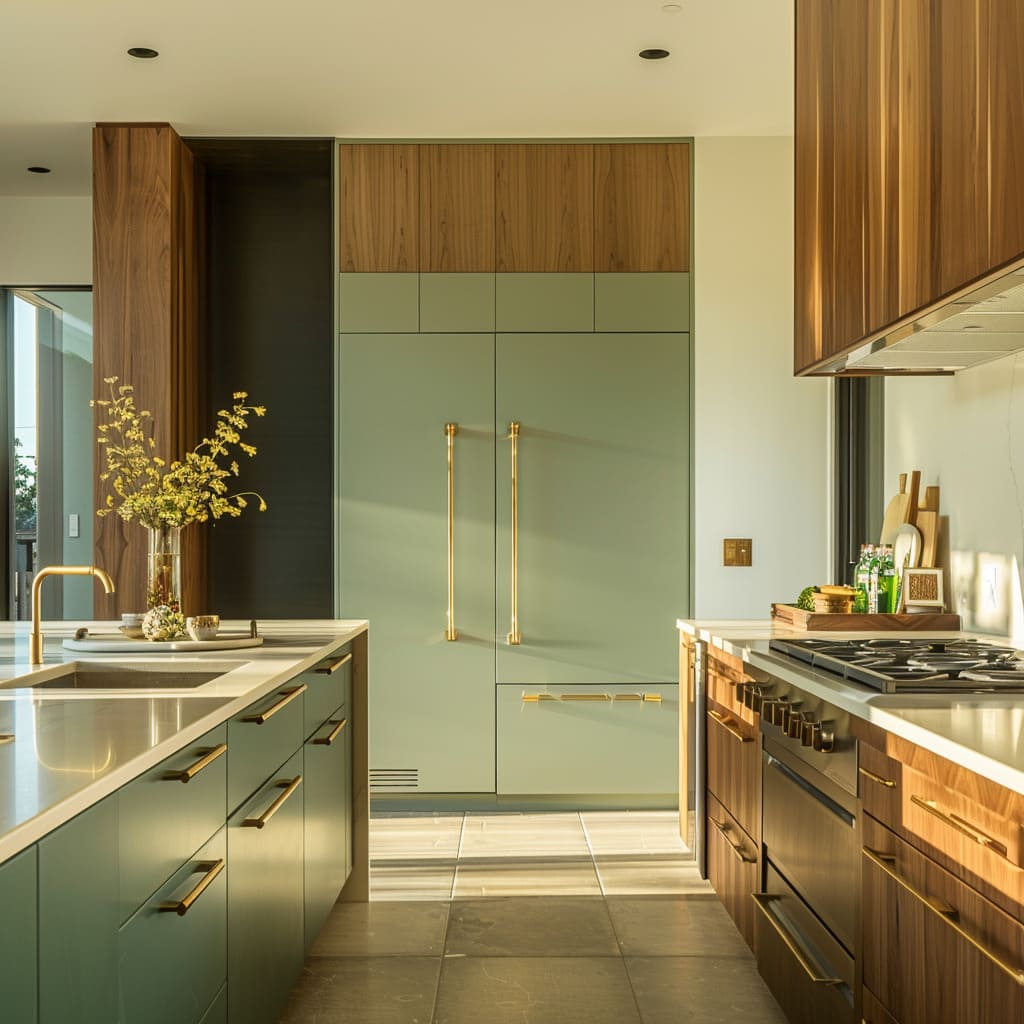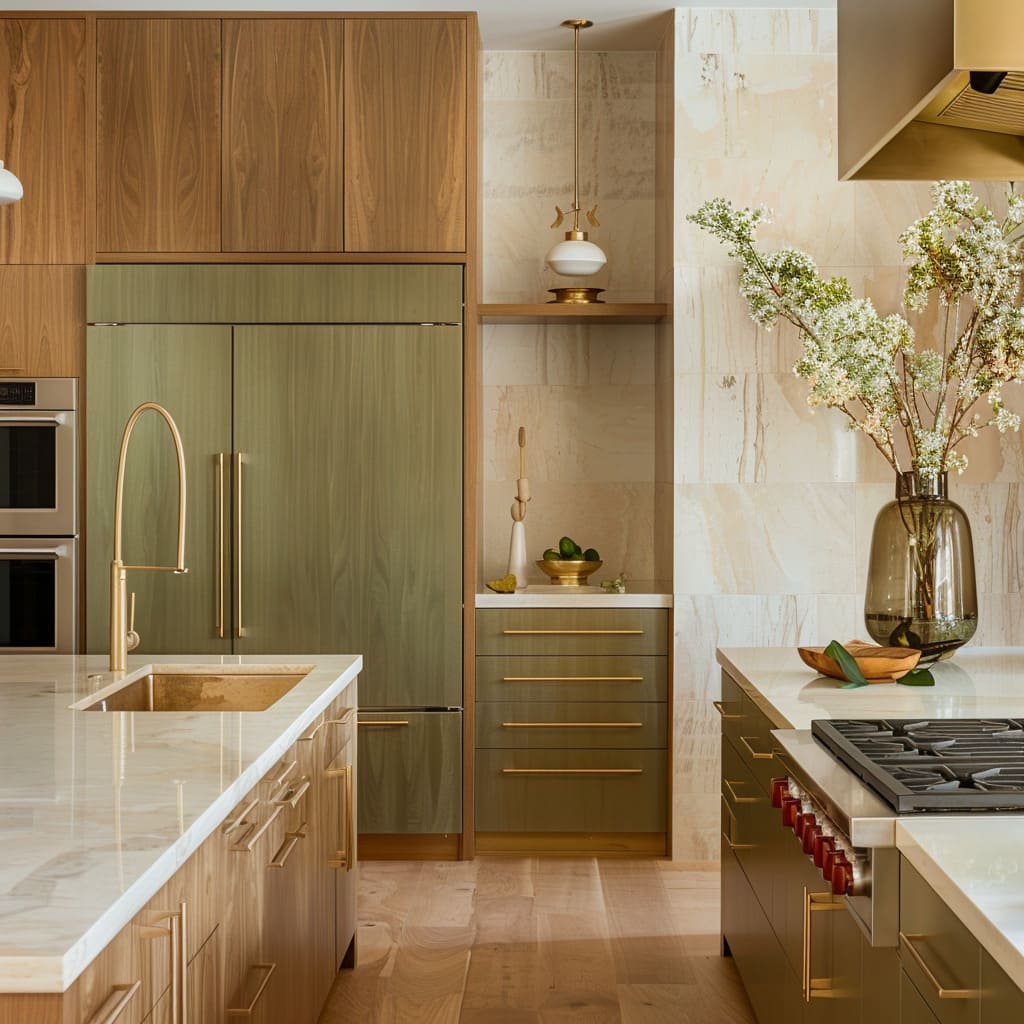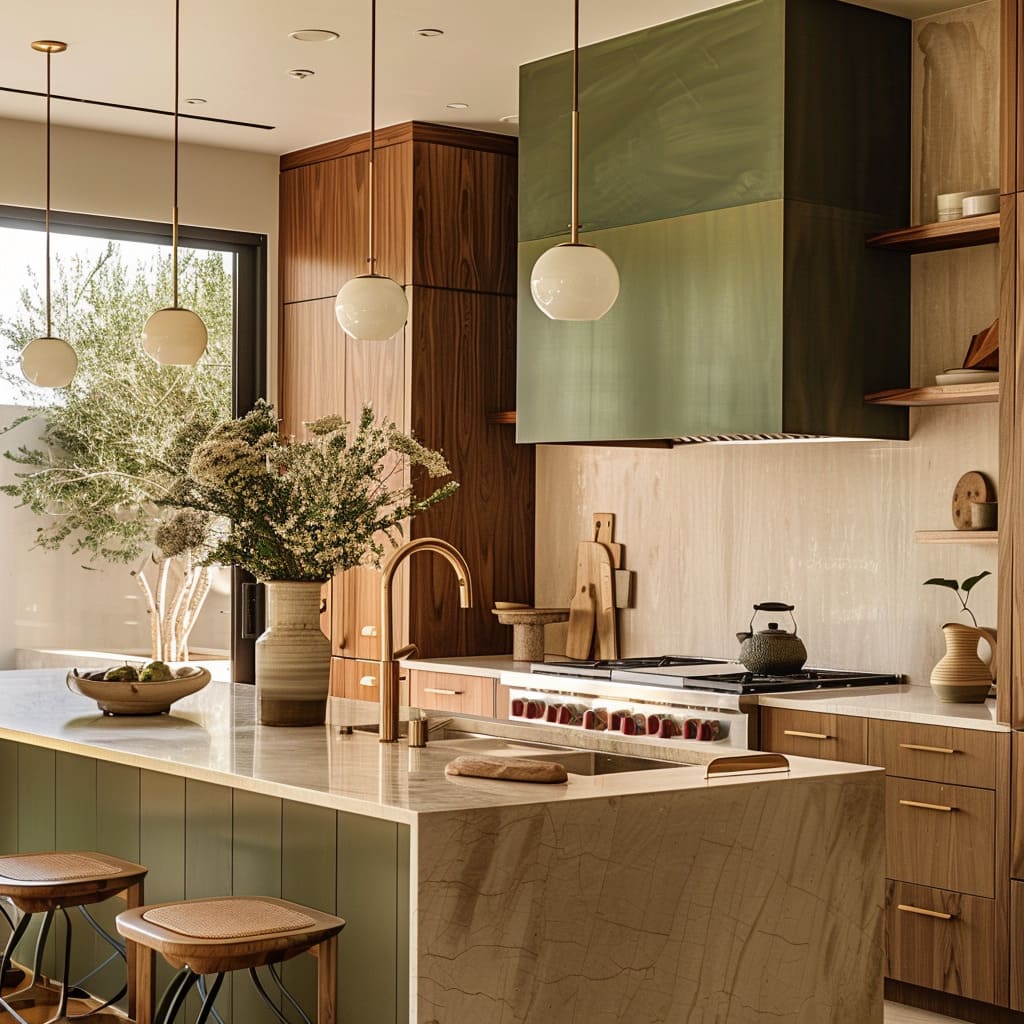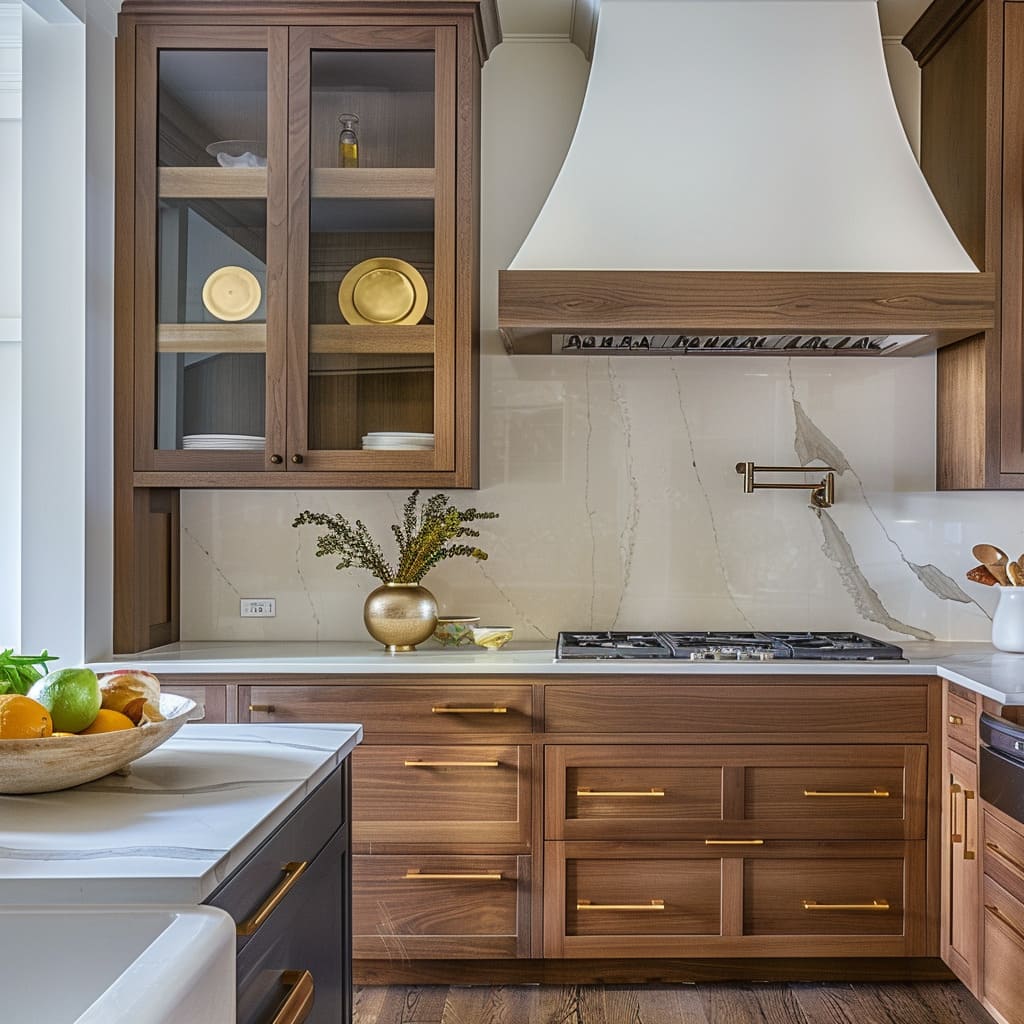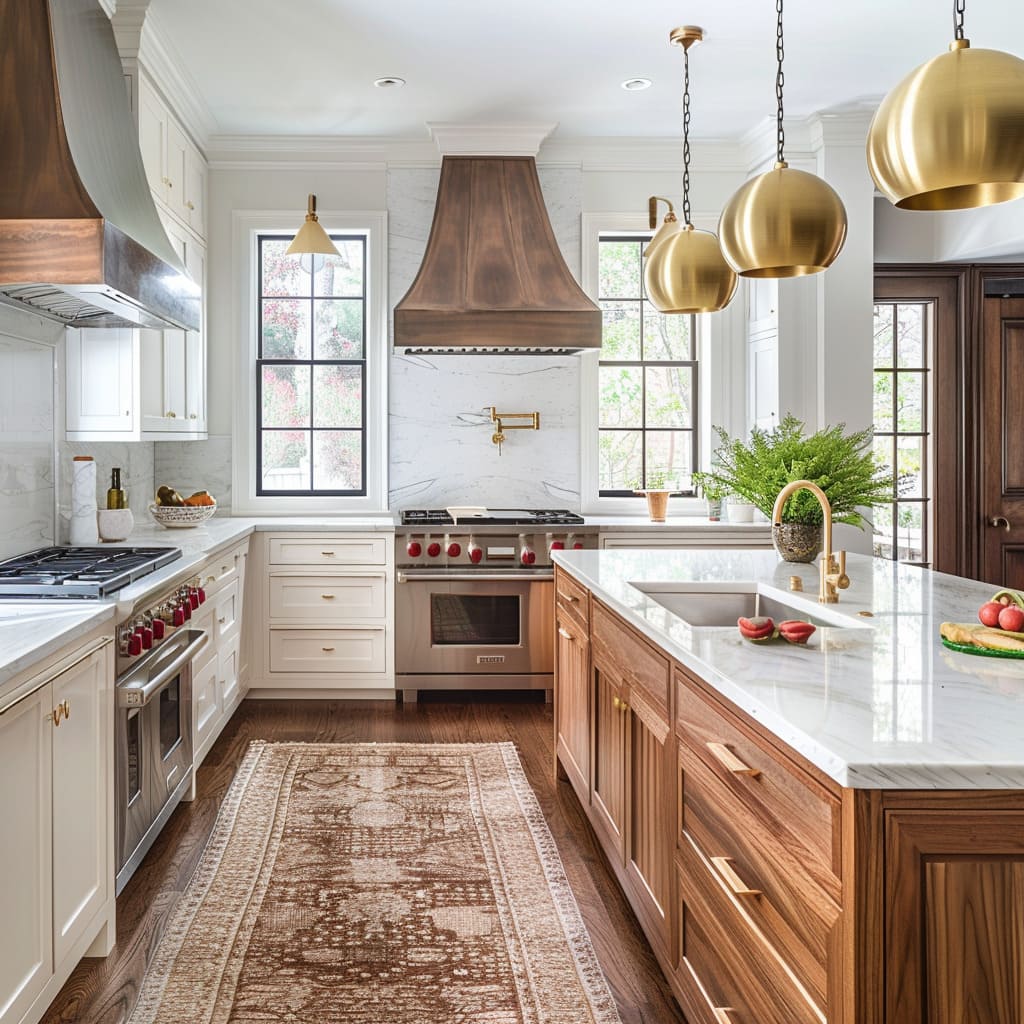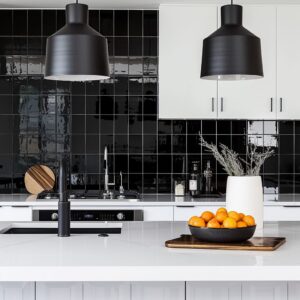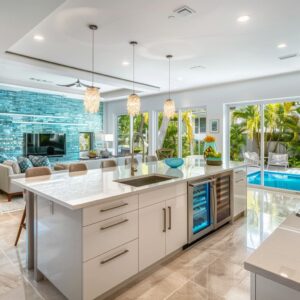Wood has always been a staple in kitchen design, known for its warmth, durability, and timeless appeal. Recently, there has been a renewed interest in incorporating wood into high-end kitchen remodels.
This resurgence is not just about tradition but about reimagining wood in contemporary, sophisticated ways that blend functionality with aesthetics. In this article, we will delve into the current trends, materials, and design elements that highlight wood’s role in luxury kitchens.
From cabinetry to countertops, we explore how wood is being used to create stunning and practical kitchen spaces that cater to modern tastes while honoring the natural beauty of the material.
The Revival of Wood in Contemporary Kitchens
Historical Context
Wood has a rich history in kitchen design, dating back centuries when it was the primary material for furniture and cabinetry. Early kitchens featured wooden cabinets, shelves, and countertops crafted from locally available timber.
Over time, the styles and techniques evolved, reflecting changes in technology and aesthetic preferences. In the mid-20th century, wood began to take a back seat as materials like stainless steel, laminates, and engineered composites became popular.
These new materials offered durability and ease of maintenance, appealing to the busy lifestyles of the era. However, the natural warmth and beauty of wood never completely fell out of favor.
It remained a cherished choice for those seeking to create cozy and inviting kitchen spaces. Today, we see a significant shift back to wood, but with a contemporary twist.
Advances in wood treatments and finishes, along with sustainable forestry practices, have made wood a viable and attractive option for modern kitchens. This revival is characterized by innovative uses of wood that balance traditional charm with contemporary design sensibilities.
The Appeal of Wood
One of the primary reasons for the resurgence of wood in kitchen design is its inherent warmth and natural beauty.
Wood brings a sense of comfort and homeliness that is hard to replicate with other materials. The unique grains, textures, and colors of different wood species add character and depth to kitchen spaces, making each installation distinct.
Wood is also incredibly versatile. It can be used in various applications, from cabinetry and countertops to flooring and accents.
This versatility allows designers to experiment with different styles, whether it’s a rustic farmhouse look, a sleek modern aesthetic, or a blend of both. The adaptability of wood makes it suitable for a wide range of design preferences and functional requirements.
Sustainability is another significant factor driving the renewed interest in wood. As environmental consciousness grows, homeowners and designers are increasingly opting for materials that have a lower impact on the planet.
Wood, when sourced responsibly, is a renewable resource that can be harvested and replenished with minimal ecological disruption. This sustainability aspect aligns well with the broader trends towards eco-friendly and green building practices.
In conclusion, the resurgence of wood in high-end kitchen remodels reflects a broader trend towards integrating natural materials in contemporary design. Its timeless appeal, versatility, and sustainability make it an ideal choice for creating luxurious, functional, and aesthetically pleasing kitchen spaces.
As we explore further, we will look at how wood is being used in specific elements of kitchen design, setting new standards in luxury and style.
Cabinetry: The Backbone of Wooden Kitchens
Types of Wood Used
When it comes to high-end kitchen cabinetry, the choice of wood plays a crucial role in determining the overall look and feel of the space. Commonly used types include walnut and oak, each offering distinct characteristics that can enhance different design aesthetics.
Walnut is prized for its rich, dark tones and straight grain, lending a sense of luxury and depth to kitchen cabinetry. It’s often used in modern and traditional designs alike, providing a versatile option that can be adapted to various styles.
Walnut’s smooth texture and durability make it an excellent choice for high-use areas. Oak, on the other hand, is known for its prominent grain patterns and light to medium brown hues.
Oak cabinetry brings a warm, rustic charm to kitchens, often favored in farmhouse or classic designs. It is robust and long-lasting, capable of withstanding the rigors of daily kitchen use.
The finishes and treatments applied to these woods further define their appearance and functionality. Natural finishes highlight the inherent beauty of the wood, showcasing its grain and texture.
Painted finishes offer a broader color palette, allowing for creative customization, while stained finishes provide a middle ground, adding color while retaining the wood’s natural look.
Design Trends
Current design trends in kitchen cabinetry emphasize a blend of minimalist aesthetics and practical functionality. Minimalist Shaker Style: This trend focuses on clean lines and understated elegance.
Cabinets in soft sage green paired with matte black handles create a calming yet sophisticated look. The simplicity of the shaker style allows the natural beauty of the wood to shine through without overwhelming the space.
Mixed Materials: Combining different materials and finishes has become a popular approach in modern kitchens. A common practice is to pair white upper cabinets with walnut lower cabinets.
This contrast not only adds visual interest but also creates a balanced look that is both contemporary and inviting. Ceiling-High Cabinets: Maximizing storage and creating a seamless design, ceiling-high cabinets are a practical solution for modern kitchens.
These cabinets provide ample storage space while maintaining a clean, uncluttered look. The continuity from floor to ceiling enhances the kitchen’s sense of height and spaciousness.
Functional Aspects
In addition to their aesthetic appeal, high-end kitchen cabinets are designed with functionality in mind.
Custom Inserts and Organization Solutions: Modern cabinetry often includes custom inserts that help keep the kitchen organized. These inserts can be tailored to store utensils, pots, pans, and other kitchen essentials neatly and efficiently.
Pull-out trays, dividers, and specialized compartments ensure that everything has its place, making the kitchen more user-friendly. Integration with Modern Appliances: Seamlessly integrating appliances into cabinetry is a hallmark of contemporary kitchen design.
Built-in refrigerators, dishwashers, and ovens are concealed behind cabinet fronts, creating a cohesive and streamlined look. This integration not only enhances the kitchen’s aesthetics but also improves its functionality by keeping the workflow smooth and uninterrupted.
Countertops and Islands: The Centerpieces
Material Choices
The choice of materials for countertops and islands significantly influences the kitchen’s overall appearance and durability. Marble: Known for its luxurious appeal, marble is a popular choice for high-end kitchens.
Its subtle veining and smooth surface add an element of elegance and sophistication. Marble countertops are not only beautiful but also durable, capable of withstanding the demands of a busy kitchen.
However, they do require regular maintenance to prevent staining and etching. Quartz: Offering a practical and elegant alternative, quartz countertops are engineered from natural quartz combined with resin.
This material is non-porous, making it resistant to stains and scratches. Quartz surfaces are available in a wide range of colors and patterns, providing a clean, uniform look that complements various kitchen styles.
Design Elements
Designing countertops and islands involves careful consideration of both form and function. Waterfall Edges: A popular design feature, waterfall edges create a seamless transition from the countertop to the floor, covering the sides of the island.
This design element adds a touch of luxury and sophistication, making the island a standout feature in the kitchen. The continuous flow of material enhances the overall aesthetics and reinforces the high-end look.
Contrasting Materials: Mixing wood with marble or quartz creates visual interest and adds depth to the kitchen design. For instance, a walnut island base with a marble countertop combines the warmth of wood with the elegance of stone, resulting in a balanced and visually appealing centerpiece.
This approach allows for creative combinations that can reflect personal style and preferences.
Functionality
Functionality is a key consideration in the design of countertops and islands. Ample Workspace for Meal Preparation: A well-designed island provides plenty of surface area for food preparation, cooking, and other kitchen tasks.
The layout should facilitate easy movement and access to essential tools and ingredients, enhancing the overall efficiency of the kitchen. Integrated Sinks and Seating Options: Many modern islands incorporate sinks and seating areas, making them multifunctional spaces.
An integrated sink allows for convenient food preparation and cleanup, while seating options transform the island into a social hub where family and friends can gather. This combination of features ensures that the island serves as both a practical workspace and a central gathering spot in the kitchen.
Range Hoods: Combining Functionality and Style
Material and Finish Trends
Range hoods have evolved from purely functional elements to key design features in modern kitchens. The choice of materials and finishes can significantly impact the kitchen’s overall look and feel.
Custom Metal Finishes: One of the emerging trends is the use of custom metal finishes. Range hoods made from rich, bronze-like metals bring a rustic charm that can warm up a kitchen space.
These finishes not only add character but also complement various design styles, from traditional to modern. The patina that develops over time on these metals adds a layer of authenticity and uniqueness.
Matching Cabinetry: Integrating the range hood with the cabinetry is another popular trend. For instance, using the same green finish as seen on some kitchen cabinets can create a cohesive and unified look.
This approach ties the range hood into the overall color palette of the kitchen, making it an integrated part of the design rather than a standalone feature.
Design Integration
Designing range hoods to serve as focal points can enhance both the functionality and aesthetic appeal of a kitchen. As Focal Points: Positioning range hoods above professional-grade gas ranges naturally draws the eye and creates a central feature in the kitchen.
The design of the hood, whether it’s a sleek modern style or a more ornate traditional look, can set the tone for the entire space. Enhancing Aesthetics: Range hoods contribute to the kitchen’s overall aesthetic, whether it’s a modern farmhouse or contemporary design.
In a modern farmhouse kitchen, a bronze range hood can add rustic charm, while in a contemporary kitchen, a minimalist design with clean lines and a matching finish can enhance the sleekness and cohesion of the space. For an estimate of your kitchen remodeling costs, try our easy-to-use cost calculator.
Backsplash: Adding Depth and Texture
Material Choices
The choice of backsplash material plays a crucial role in defining the kitchen’s look and feel. Polished Stone and Marble Tiles: These materials add a touch of luxury and sophistication.
Polished stone and marble backsplashes provide a smooth, reflective surface that can make the kitchen feel more spacious. The natural veining and variations in the stone create visual interest and depth.
Glossy Subway Tiles: For a more modern touch, glossy subway tiles are a popular choice. These tiles offer a sleek and clean look, reflecting light and enhancing the brightness of the kitchen.
Their simplicity allows them to blend well with various design elements, making them a versatile option.
Design Trends
Current design trends in backsplashes emphasize continuity and reflectivity to enhance the kitchen’s overall appearance. Continuity of Material: Extending the countertop material up the wall to create the backsplash is a trend that promotes visual continuity.
This seamless transition from countertop to backsplash can make the kitchen look more cohesive and elegant. Using the same material reduces visual clutter and highlights the beauty of the chosen surface.
Reflective Finishes: Using reflective finishes in the backsplash enhances the light and depth in the kitchen. These finishes can make the space feel larger and more open by bouncing light around the room.
Reflective materials like polished stone or glossy tiles add a subtle sheen that enhances the overall aesthetic.
Appliances: Seamlessly Integrating Technology
High-End Choices
The integration of high-end appliances is essential in modern kitchen design, combining cutting-edge technology with sleek aesthetics. Stainless Steel Professional-Grade Appliances: Stainless steel ranges, ovens, and integrated refrigerators are staples in high-end kitchens.
These appliances offer superior performance and durability, while their sleek, metallic finish provides a modern and professional look. The clean lines and reflective surfaces of stainless steel appliances complement various design styles, from contemporary to industrial.
Concealed Appliances: To maintain a streamlined look, many kitchens now feature concealed appliances. Refrigerators, dishwashers, and even some ovens are hidden behind custom cabinet fronts that match the rest of the cabinetry.
This approach creates a cohesive and uncluttered appearance, allowing the kitchen’s design elements to shine without interruption.
Placement and Functionality
Strategic placement and seamless integration of appliances are key to optimizing the kitchen’s functionality and workflow. Strategic Placement: Positioning appliances in a way that maximizes efficiency is crucial.
For example, placing the refrigerator near the prep area and the oven close to the cooking zone reduces the need to move around the kitchen unnecessarily. This thoughtful arrangement enhances the cooking experience and makes the kitchen more user-friendly.
Blending with Cabinetry: Integrating appliances with the cabinetry ensures a harmonious look. Custom panels that match the surrounding cabinets can disguise dishwashers and refrigerators, creating a unified design.
This blending technique helps maintain a clean and cohesive appearance, emphasizing the kitchen’s aesthetic qualities while ensuring all necessary appliances are within easy reach.
Lighting: Enhancing Ambiance and Function
Types of Lighting
Lighting plays a crucial role in both the functionality and atmosphere of a kitchen. The right lighting can enhance the space, highlight key features, and create a warm and inviting environment.
Pendant Lights with Modern Designs: Pendant lights are a popular choice for modern kitchens, offering both functionality and style. These lights hang from the ceiling, providing focused illumination over specific areas such as kitchen islands or dining tables.
Contemporary pendant lights come in various shapes, sizes, and materials, allowing for customization to fit any design aesthetic. They serve as a statement piece, drawing attention and adding a touch of sophistication.
Recessed and Under-Cabinet LED Lighting: Recessed lighting, also known as can lighting, is installed in the ceiling and provides general illumination throughout the kitchen. It is unobtrusive, making it ideal for maintaining a clean and streamlined look.
Under-cabinet LED lighting is another essential component, offering direct light over countertops and workspaces. This type of lighting is both practical and decorative, enhancing visibility for tasks like chopping and cooking while also highlighting the backsplash and countertop materials.
Design Integration
Integrating lighting design into the overall kitchen layout ensures that the space is both functional and aesthetically pleasing. Creating Focal Points with Statement Lighting: Pendant lights and chandeliers can be used to create focal points in the kitchen.
For example, a row of pendant lights over an island can draw the eye and define the area as a central gathering spot. These lights not only illuminate the space but also add a decorative element that can complement the kitchen’s design theme.
Ensuring Even Illumination and Highlighting Key Areas: Recessed lighting and under-cabinet lighting ensure that the kitchen is evenly illuminated, preventing shadows and dark corners. This type of lighting is particularly important in work areas where good visibility is essential.
Additionally, strategically placed lights can highlight key design features such as open shelving, artwork, or architectural details, adding depth and dimension to the space.
Windows and Natural Light: Bringing the Outdoors In
Maximizing Natural Light
Natural light has a profound impact on the look and feel of a kitchen. Large windows are a key feature in modern kitchen design, allowing ample natural light to flood the space.
Large Windows for a Bright and Inviting Atmosphere: Incorporating large windows into the kitchen design helps create a bright and inviting atmosphere. Floor-to-ceiling windows, bay windows, or even skylights can maximize the amount of natural light entering the room, making the kitchen feel more open and spacious.
Black Window Frames for a Contemporary Touch: Black window frames are a popular choice for adding a contemporary touch to the kitchen. The contrast between the dark frames and the bright light enhances the overall aesthetic, making the windows a focal point in the design.
This modern detail complements various styles, from industrial to minimalist, and adds a sleek, polished look.
Benefits
Maximizing natural light in the kitchen offers numerous benefits, both aesthetic and functional. Enhancing the Beauty of Wood and Other Materials: Natural light enhances the beauty of wood cabinetry, stone countertops, and other materials used in the kitchen.
It brings out the natural colors and textures, making the space feel more vibrant and dynamic. The play of light and shadow can add depth and interest to the design, highlighting different elements throughout the day.
Connecting the Kitchen to the Outdoors: Large windows create a visual connection between the kitchen and the outdoors. This connection can make the kitchen feel more expansive and integrated with the surrounding environment.
Whether the view is of a lush garden, a cityscape, or a serene backyard, bringing the outdoors in enhances the overall experience of the space.
Flooring: The Foundation of the Design
Material Choices
The choice of flooring material sets the foundation for the kitchen’s design, impacting both its appearance and functionality. Wide-Plank Wood Flooring for Warmth and Continuity: Wide-plank wood flooring is a popular choice for high-end kitchens, offering warmth and a sense of continuity.
The broad planks create a seamless look, reducing the number of visible seams and enhancing the natural beauty of the wood. This type of flooring complements various styles, from rustic to contemporary, and adds a timeless appeal to the space.
Polished Concrete for a Modern Industrial Look: Polished concrete flooring provides a sleek, modern industrial look that is both durable and easy to maintain. The smooth surface reflects light, adding a sense of spaciousness to the kitchen.
Concrete can be stained or colored to match the design palette, offering a versatile option for contemporary kitchens.
Design Considerations
Choosing the right flooring involves considering factors such as durability, maintenance, and how the material complements the overall color scheme. Durability and Ease of Maintenance: Kitchen floors need to withstand heavy foot traffic, spills, and frequent cleaning.
Materials like wood and concrete are chosen for their durability and ease of maintenance. Wood floors can be sealed to protect against moisture and stains, while concrete is inherently resistant to most types of wear and tear.
Complementing the Overall Color Scheme: The flooring should complement the kitchen’s color scheme and design elements. For example, the warm tones of wood flooring can enhance the natural beauty of wooden cabinetry, while polished concrete can provide a neutral backdrop that highlights bold colors and modern fixtures.
The choice of flooring should integrate seamlessly with the countertops, cabinetry, and other design features, creating a cohesive and harmonious look.
Decor and Accessories: Personalizing the Space
Minimalist Approach
When it comes to decorating a high-end kitchen, less is often more. A minimalist approach allows the beauty of the materials and the elegance of the design to shine through.
Thoughtfully chosen items can enhance both the natural and modern aesthetics of the space without overwhelming it. Incorporating fresh greenery is a simple yet effective way to bring life and color into the kitchen.
Plants can be placed on countertops, open shelves, or even hung from the ceiling. They not only improve air quality but also add a touch of nature that complements the use of wood and other natural materials.
Wooden cutting boards are another practical and stylish accessory. They can be displayed on countertops or hung on the wall, adding a rustic charm and emphasizing the kitchen’s natural elements.
Similarly, ceramic bowls in neutral tones can be used to store fruits or other items, adding texture and a handcrafted feel to the space. These bowls can be placed on open shelves or countertops, contributing to the kitchen’s overall aesthetic while serving a functional purpose.
Functional and Stylish
In a high-end kitchen, decor and accessories should combine style with functionality. Every item should not only enhance the look of the kitchen but also serve a practical purpose.
Storage jars made from glass or ceramic are perfect for keeping dry goods like pasta, grains, and spices. They can be neatly arranged on open shelves or in glass-fronted cabinets, making it easy to see their contents while adding a decorative element.
Choosing jars with airtight seals ensures that ingredients stay fresh. Cookware and utensils can also serve as decor when they are stylishly designed.
Hanging pots and pans from a rack or displaying utensils in a holder on the countertop keeps them within easy reach and adds a professional, lived-in feel to the kitchen. Textiles, such as dish towels and oven mitts, should be chosen with care.
Opt for high-quality fabrics in colors and patterns that complement the kitchen’s color scheme. These items can be hung on hooks or draped over the oven handle, adding a touch of softness and warmth to the space.
Functionality: Designing for Everyday Use
Efficient Layouts
An efficient layout is key to a functional kitchen. The design should facilitate easy movement and accessibility, ensuring that all necessary items and appliances are within reach.
The work triangle—the optimal distance between the sink, stove, and refrigerator—is a fundamental concept in kitchen design. This layout minimizes the distance between the most used areas, making meal preparation more efficient.
Additionally, placing the dishwasher near the sink and the trash bin near the prep area further enhances workflow efficiency. Ample storage solutions are essential to keep the kitchen organized and clutter-free.
This includes a combination of cabinets, drawers, and open shelves. Deep drawers for pots and pans, pull-out trays for spices, and dedicated cabinets for small appliances can help maintain order.
Custom inserts and dividers can maximize the utility of every inch of storage space.
High-End Materials and Modern Features
Integrating high-end materials with modern appliances elevates the kitchen’s functionality and aesthetic. Quality materials not only look better but also last longer, making them a wise investment.
Countertops made from marble, quartz, or granite are durable and offer a sleek, sophisticated look. These materials are resistant to scratches, heat, and stains, making them ideal for busy kitchens.
Modern appliances should be seamlessly integrated into the kitchen design. Built-in refrigerators, ovens, and dishwashers create a cohesive look and save space.
Choosing appliances with smart technology can add convenience, such as ovens with programmable settings or refrigerators with touchscreens for managing groceries. Thoughtful design features like under-cabinet lighting, soft-close drawers, and pull-out pantry shelves enhance the kitchen’s functionality.
These features make daily tasks easier and contribute to a more enjoyable cooking and dining experience.
Conclusion
In summary, re-thinking wood in high-end kitchen remodels involves more than just choosing the right materials. It requires a comprehensive approach that considers aesthetics, functionality, and personal style.
From cabinetry and countertops to lighting and accessories, every element plays a crucial role in creating a kitchen that is both beautiful and practical. Looking ahead, the trend towards integrating natural materials and sustainable practices in kitchen design is likely to continue.
As technology advances, we can expect even more innovative solutions that blend style with functionality. Ultimately, wood’s timeless appeal and versatility ensure it will remain a key component in luxury kitchens for years to come.
Whether you’re planning a remodel or simply looking to refresh your space, embracing these trends can help create a kitchen that is truly a reflection of your taste and lifestyle.

